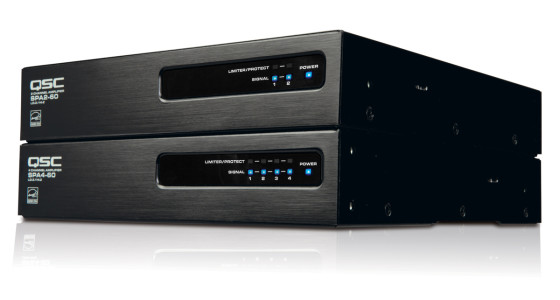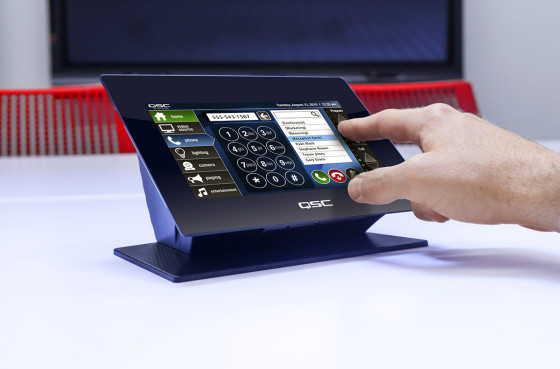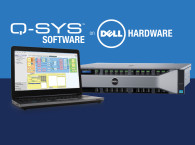
As part of this new family, QSC will introduce in Orlando, FL, the new SPA Amplifier Series, addressing customer demand for amplifiers to meet the needs of the corporate AV market. As the Costa Mesa company describes, the new amplifiers were developed to be a powerful yet affordable series, adapted for boardrooms, conference rooms, and other corporate spaces where multiple speakers are in use.
“We are pleased to answer requests from our loyal customers for an amplifier solution that brings the power and sensation of our live-event amplifiers into the boardroom,” says Joe Pham, President and CEO. “Our SPA amplifier series is Energy Star compliant and offers flexibility to integrators with two amplifier solutions. The SPA2-60 offers two channels of Low-Z output into 4Ω or 8Ωs, but it can be bridged to provide 70V or 100V output. The SPA4-60 is similar but offers more channels enabling elegant solutions like a pair of stereo channels with a single 70V or 100V output, or a Sub/Sat combination. This capability minimizes the amount of inventory and SKUs our customers need to manage for products that represent the majority of their business.”
The SPA amplifiers also allow bridgeable channels to provide 120W into 70V or 100V load, eliminating the need for additional amplifiers. All models are half-rack size and are complemented with a unique rack mounting system for flexible mounting options in boardrooms, such as under the table, wall-mounted behind a display, or side-by-side in a credenza rack. They also feature remote control capabilities for applications such as standby mode for fire and safety paging.
New TSC-7t PoE Tabletop Touchscreen
Complementing its offerings for the corporate AV market, QSC designed a new PoE tabletop touchscreen, featuring Bluetooth and Micro USB On-The-Go (OTG) connections. The new TSC-7t PoE Tabletop Touchscreen can be used on any Q-SYS networked audio solution (Q-LAN), including the new Core 110f - also part of the family of solutions to be introduced at InfoComm 2015.

With its 7” (17.78 cm) wide screen, the high-resolution PoE tabletop touchscreen is powered over Ethernet or DC line input and functions as an elegant telephone dialer and can additionally be used to control a myriad of third-party devices prevalent in boardrooms and meeting rooms — via the Core (no additional control processor box required).
Additionally, the TSC-7t meets a common BYOD (bring your own device) audio need. When meeting participants run UC or web conferencing applications on their own devices, they can easily connect the 2-way audio from that device to the Q-SYS system using the Bluetooth and or Micro USB On-The-Go (OTG) connections on the TSC-7t.
“Today’s business professionals expect to use their personal devices as tools for collaboration and communication,” notes Joe Pham, QSC President and CEO. “The TSC-7t allows them to easily introduce their own devices to their meeting room’s networked audio. This functionality is just one example of how QSC is innovating solutions for the Corporate AV market.”
New Q-SYS Core 110f DSP
The Q-SYS Core 110f is the latest addition to company’s Q-SYS lineup of network audio solutions, which are built on modern Intel-based technologies and use a Linux Real Time Operating System. The new, smaller Core 110f brings powerful yet affordable software based audio processing product to the corporate AV market.

“Q-SYS products will shape both QSC and the convergence of AV and IT,” says Joe Pham, President and CEO. “The Q-SYS Core 110f delivers a seamless collaboration experience in boardrooms, conference rooms, and other corporate spaces where businesses need to focus on solving their problems instead of concerning themselves with the AV technology. They can rely on QSC for solutions built around performance, reliability, ease of use—backed by people who care.”
The Core 110f will allow AV integrators and IT managers alike to deliver seamless networking integration via Q-LAN, which uses IT standard Layer-3 protocols, allowing the ability to coexist with all other data and the use of standard Ethernet switches. Additionally, the Core 110f is AES67-ready to provide interoperability with a growing list of 3rd party network audio products which will support the standard.
According to QSC, the software-based implementation of DSP delivers more processing power, giving integrators the flexibility to add automatic echo cancelation channels without additional hardware. It also allows software configuration of flex analog audio channels as inputs or outputs for nearly any matrix size, and select VoIP or POTS, or both telephony connectivity options without the hassle of managing multiple SKUs or purchasing additional hardware.
In addition to the eight fixed mic/line inputs and eight fixed outputs, the Q-SYS Core 110f provides eight flexible channels that can be software defined in real time as inputs or outputs. Single channel granularity makes it possible to configure each channel independent of the others giving nearly all the flexibility of card based systems without the hassle and cost. In total, Core 110f provides an overall class leading 24 I/O capability in 1 rack unit space.
The new Core 110f can also provide up to 16x16 USB audio channels that can be split in any combination or ratio and appear in the host operating system as multiple devices over one USB connection such as a 1x1 speaker phone plus an audio recording interface. In addition, the Core 110f can act as a host for future USB audio devices that can be connected directly to the Core 110f for processing and distribution.
www.qsc.com/infocomm2015






